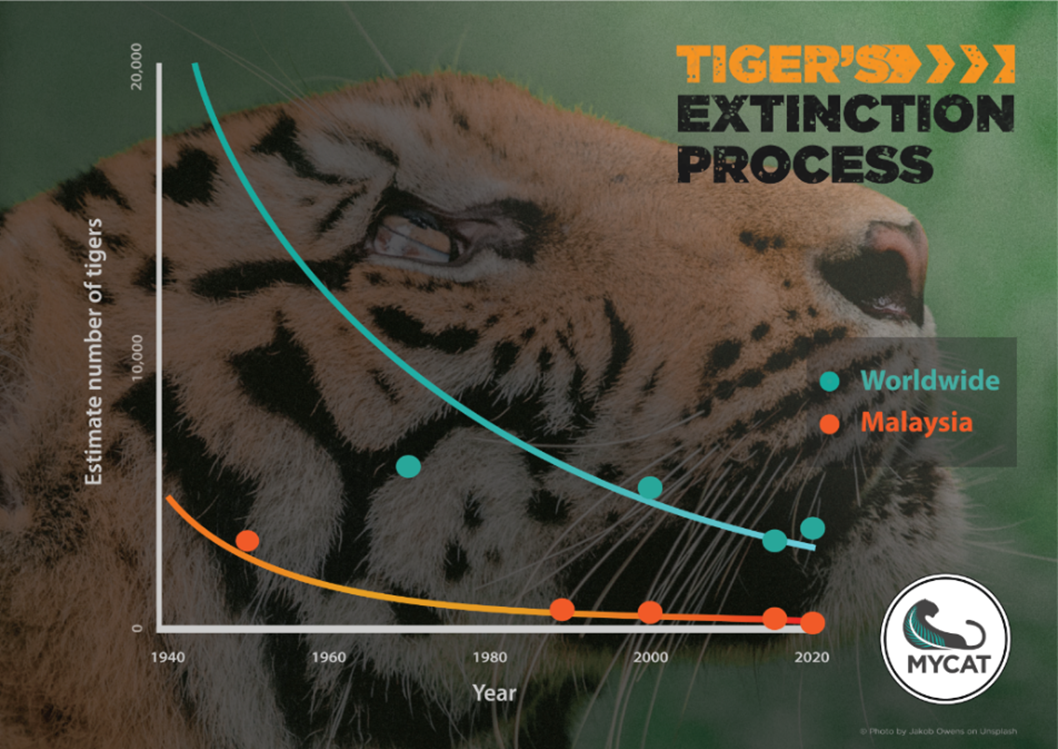Photo Credit: Dr Kae Kawanishi
A PRIVATE CONVERSATION WITH
DR KAE KAWANISHI
General Manager and Head of Conservation,
Malaysian Conservation Alliance for Tigers (MYCAT)
how to book this session
Kae is generously donating her time to meet up with three lucky individuals and/or group(s) in March! Here is how you can book a slot:
Write to swag.cat.sg@gmail.com by 8am, 8 March 2023
1) Name(s) of person or everyone in the group (up to 4 people)
2) Short introduction
3) Main contact number
4) Topic(s) of conversation
5) Preferred date and flexibility:
Slot 1 - Monday, 13 March 2023, 3 p.m. - 5 p.m.
Slot 2- Tuesday, 14 March 2023, 3 p.m. - 5 p.m.
Slot 3 - Wednesday, 15 March 2023, 3 p.m. - 5 p.m.
* A venue in central Singapore will be sent to the selected three people and/or groups by noon, 11 March 2023. Please note that this is a personal conversation and not a media interview.

Kae's Bio
Dr Kae Kawanishi
General Manager and Head of Conservation for
Malaysian Conservation Alliance for Tigers (MYCAT)
Born in Japan and studied in the USA, in pursuit of her dream to become a wildlife conservationist, Dr Kae has lived and worked in five countries. As a PhD student from University of Florida and with support from the Malaysian government, she came to Malaysia in 1998 to conduct the first scientific research on the ecology of Malayan Tigers. That three-year research found that Taman Negara National Park had the largest known tiger population in Southeast Asia at that time. Subsequently she joined Malaysia’s Wildlife Department (locally known as PERHILITAN) as Technical Advisor for tiger research and conservation for three years and helped the government establish MYCAT to bring the government and NGOs in the spirit of Saving Tigers Together towards recovery of the Malayan Tiger population in the wild.
In 2010, MYCAT expanded the Saving Tigers Together spirit to engage members of the public under its Citizen Action for Tigers (CAT) program. Through CAT, MYCAT aims to educate members of the public and inspire them to action for protecting wild nature with the Tiger as the ultimate flagship species. CAT Walk® is an anti-poaching surveillance walks conducted at poaching hotspots by citizen conservationists and to date, more than 2000 people from 38 countries participated to protect tigers and other wildlife from threats like poaching and deforestation. As a result, endangered wildlife is recovering. Besides CAT Walk, MYCAT empowers local indigenous communities to defend wildlife and restore forests through community ranger and reforestation projects.
For more than three decades Dr Kae has studied the way of top predators in the New and Old-World rainforests. Tracking these elusive big cats by day and sleeping in untamed jungles at the mercy of all wild things at night made her realize who she was and why she was on this planet Earth. Because of this, despite the continuous losses, her struggle to save the last remaining wilderness continues. To date, she has spoken for wild tigers at more than 200 occasions and raised and managed USD4million for tiger conservation.
Selected publications:
- Kawanishi, K. 2015. Panthera tigris ssp. jacksoni. The IUCN Red List of Threatened Species. Version 2015.
- Malaysian Conservation Alliance for Tigers. 2014. MYCAT TRACKS: Malayan Tiger’s Struggle for Existence. Petaling Jaya, Malaysia. (Editor-in-Chief and Contributor).
- Kawanishi, K., G. R. Clements, M. Gumal, G. Goldthrope, Y. Mohd Nawayai, and D. S. K. Sharma. 2013. Using BAD for good: how best available data facilitated a precautionary policy change to improve protection of the prey of the tiger Panthera tigris in Malaysia. Oryx 47 (3): 420-426.
- Kawanishi, K., C. A. Yeap, C. R. Shepherd, M. Gumal, S. Suksuwan, and S. M. Bidin. 2012. CAT Walks in Sungai Yu Tiger Corridor: public empowerment and engagement in wildlife conservation. Cat News 56: 9-11.
- Kawanishi, K., S. H. Neo Liang, C. Darimont, T. E. Reimchen, and M. E. Sunquist. 2012. Isotopic niche differentiation among mammals of a rainforest in Peninsular Malaysia. Raffles Bulletin of Zoology 60 (1): 233-239.
- Kawanishi, K., C. A. Yeap, E. John, M. Gumal, and S. Sukor. 2011. Malaysia, a leading country for green infrastructure. Cat News 55:38-40. http://mycat.my/publications/
- Kawanishi, K., M. E. Sunquist, E. Eizirik, A. J. Lynam, D. Ngoprasert, W. N. Wan Shahruddin, M. R. Darmaraj, S. K. S. Dionysius, and R. Steinmetz. 2010. Near fixation of melanism in leopards of the Malay Peninsula. Journal of Zoology 282: 201-206.
- Kawanishi, K. and J. Seidensticker. 2010. Collaboration and Partnerships are Essential to Sustain Wild Tiger Populations. Chapter 11, pages 175-184 in Tigers of the World: The Science, Politics and Conservation of Panthera tigris. 2nd ed. Eds by Tilson, R. and P. Nyhus. Oxford, Elsevier Ltd.
- Kawanishi, K., M. Gumal, L. A. Shepherd, G. Goldthorpe, C. R. Shepherd, K. Krishnasamy, and A. K. A. Hashim. Malayan Tiger. 2010. Chapter 29, pages 367-376 in Tigers of the World: The Science, Politics and Conservation of Panthera tigris. 2nd ed. Eds by Tilson, R. and P. Nyhus. Oxford, Elsevier Ltd.
- Malaysian Conservation Alliance for Tigers. 2010. MYCAT TRACKS: Highlight of the implementation of the National Tiger Conservation Action Plan in 2008 and 2009. Petaling Jaya, Malaysia. Eds by L. A. Shepherd and K. Kawanishi.
- Kawanishi, K. and M. Sunquist. 2008. Food habits and activity patterns of the Asiatic golden cat Catopuma temminkii and dhole Cuon alpinus in a primary rainforest of Peninsular Malaysia. Mammal Study 33: 173–177.
- Department of Wildlife and National Parks Peninsular Malaysia. 2008. National Tiger Action Plan for Malaysia. DWNP, Kuala Lumpur, Malaysia. (As Drafting Committee Leader)
- MacKenzie, D. I, J. D. Nichols, N. Sutton, K. Kawanishi and L. L. Bailey. 2005. Improving Inferences in Population Studies of Rare Species that are Detected Imperfectly. Ecology 86(5):1101-1113
- Kawanishi, K. and M. Sunquist. 2004. Conservation status of tigers in a primary rainforest of Peninsular Malaysia. Biological Conservation 120 (3): 329-344.
- Kawanishi, K., Y. Siti Hawa, A. H. Abdul Kadir and T. Rahmat. 2003. Distribution and potential population size of the tiger in Peninsular Malaysia. Journal of Wildlife and Parks (Malaysia) 21: 29-50.
Recent media:
No fiercer tiger defender than Kae
Tiger biologist calls for strict enforcement to save the Malayan tiger
Pahang – key to survival for remaining 100 Malayan tigers
It’s the Year of the Tiger, let’s make sure they don’t become extinct
It’s the year of the tiger, but it’s doom for the Malayan tiger
Hard talk with tiger biologist, Dr Kae Kawanishi on Covid-19 lessons
Malayan tigers are nearly extinct, a biologist warns
Malayan tiger in crisis – Kae Kawanishi
Malayan tiger in crisis as poaching threatens to wipe our big cat
How Singaporeans can help save the Malayan tiger

